 Haa Valley – Adjoining the districts of Paro, Chhukha and Samtse, Haa valley is one of the most picturesque places in the Kingdom, spread over an area of 1706 sq. km. During pre-Buddhist era, Haa valley was known for its animist tradition. Inhabitants then were enthused in offering animal blood to their local deities. Haa valley BhutanSuch animist belief however was transformed into peaceful Buddhist tradition in 8th century by Guru Padmasambhava. The tantric master, Guru Padmasambhava, subdued the local deities like Ap Chundu and made the guardians of the Buddhist tradition. However, the traces of this belief system are still noticed in the form of festivals and rituals.The Haa valley was opened for the first time to foreign tourists in 2002. It is culturally rich valley and some of famous sites in this region are : 7th century Lhakhang Karpo (White temple) and Lhakhang Nagpo (Black temple) at the foothills of a venerated three brotherly mountains known as Meri Puensum. The grand annual Haa Tshechu is also performed here at Lhakhang Karpo on the 8th-10th day of the 8th Bhutanese month.
Haa Valley – Adjoining the districts of Paro, Chhukha and Samtse, Haa valley is one of the most picturesque places in the Kingdom, spread over an area of 1706 sq. km. During pre-Buddhist era, Haa valley was known for its animist tradition. Inhabitants then were enthused in offering animal blood to their local deities. Haa valley BhutanSuch animist belief however was transformed into peaceful Buddhist tradition in 8th century by Guru Padmasambhava. The tantric master, Guru Padmasambhava, subdued the local deities like Ap Chundu and made the guardians of the Buddhist tradition. However, the traces of this belief system are still noticed in the form of festivals and rituals.The Haa valley was opened for the first time to foreign tourists in 2002. It is culturally rich valley and some of famous sites in this region are : 7th century Lhakhang Karpo (White temple) and Lhakhang Nagpo (Black temple) at the foothills of a venerated three brotherly mountains known as Meri Puensum. The grand annual Haa Tshechu is also performed here at Lhakhang Karpo on the 8th-10th day of the 8th Bhutanese month.
The Haa Wangchuklo Dzong built in 1915 after the Dumchog Dzong was razed to the ground by fire is worth visiting. The other place of interest which involves some walking includes the hike to the 8th century Juneydrag, Katsho Goempa, Drana Trashidingkhag, Yangto Goempa, Jamtoe Goempa, Shelkardrag, Takchu Goempa and Haa Goempa.
The valley is also unparalleled in Bhutan in terms of the diversity of the folk culture, legends and shamanistic rituals. The shamanistic traditions is vividly practiced in almost all the communities, most notable of which is the annual ceremony to honour Ap Chundu, the guardian deity of the valley. The valley is also a paradise for nature lovers and travelling there is a very rewarding experience.
The drive to Haa valley crosses 3988m Chele-la pass, from where one can have a superb views of Mount. Chomolhari & Jichu Drakey. It is also an ideal place to take short walk, enjoying panoramic vistas.
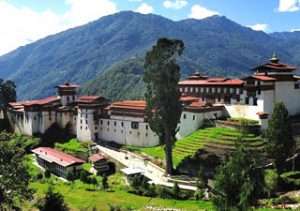 Phuentsholing (alt. 300m / 985 ft) – The frontier town, it is a thriving commercial centre, situated directly at the base of Himalayan foothills. It is a fascinating place where different ethnic groups mingle prominently Indian, Bhutanese and Nepalese. Being the border town, Phuentsholing serves as the convenient entry/exit point for Bhutan and also the important link to visit the Indian state of West Bengal, Sikkim and Assam.Places of interest in and around Phuentsholing
Phuentsholing (alt. 300m / 985 ft) – The frontier town, it is a thriving commercial centre, situated directly at the base of Himalayan foothills. It is a fascinating place where different ethnic groups mingle prominently Indian, Bhutanese and Nepalese. Being the border town, Phuentsholing serves as the convenient entry/exit point for Bhutan and also the important link to visit the Indian state of West Bengal, Sikkim and Assam.Places of interest in and around Phuentsholing
Zangtho Pelri Lhakhang
Situated in city centre, this small temple represents the heaven of Guru Rinpoche. Zhangtho Pelri Phuentsholing BhutanOn ground floor there are statues of eight manifestations of Guru Rinpoche and paintings on Buddha’s life while the next floor contains eight Bodhisattavas and statues of Avalokiteshvara and Shabdrung Ngawang Namgyal. On top floor, there is a main statue of Amitabha.
Kharbandi Goemba
Founded in 1967 by Royal Grand Mother, Ashi Phuntsho Choedron and situated at the altitude of 400m, this beautiful monastery contains paintings on the life of Buddha, statues of Shabdrung Ngawang Namgyal and Guru Rinpoche. From the monastery garden there is a fascinating view of Phuentsholing town and surrounding plains.
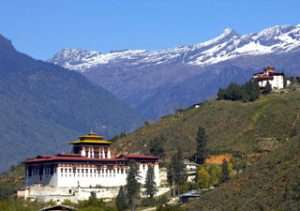 Paro (alt. 2200m/7218ft) – The beautiful valley of Paro encapsulates within itself a rich culture, scenic beauty and hundreds of myths and legends. It is home to many of Bhutan’s oldest temples and monasteries, National Museum and country’s only airport. Mount. Chomolhari (7,314m) reigns in white glory at the northern end of the valley and its glacial water plunge through deep gorges to form Pa Chhu (Paro river). Paro is also one of the most fertile valley in the Kingdom producing a bulk of the locally famous red rice from its terraced fields.
Paro (alt. 2200m/7218ft) – The beautiful valley of Paro encapsulates within itself a rich culture, scenic beauty and hundreds of myths and legends. It is home to many of Bhutan’s oldest temples and monasteries, National Museum and country’s only airport. Mount. Chomolhari (7,314m) reigns in white glory at the northern end of the valley and its glacial water plunge through deep gorges to form Pa Chhu (Paro river). Paro is also one of the most fertile valley in the Kingdom producing a bulk of the locally famous red rice from its terraced fields.
Places of interest in and around Paro
Rinpung Dzong
Built in 1646 by Shabdrung Ngawang Namgyal , the first National Museum Parospiritual and temporal ruler of Bhutan, the Dzong houses the monastic body of Paro, the office of the Dzongda (district administrative head) and Thrimpon (judge) of Paro district. The approach to the Dzong is through a traditional covered bridge called Nemi Zam. A walk through the bridge, over a stone inlaid path, offers a good view of the architectural wonder of the Dzong as well as life around it. It is also the venue of Paro Tshechu, held once a year in the spring.
Ta Dzong
One time watch tower built to defend Rinpung Dozng during inter-valley wars of the 17th century, since 1967 Ta Dzong is serving as the National Museum of the country. It holds fascinating collection of art, relics, religious thangkha paintings and Bhutan’s exquisite postage stamps. The museum circular shape augments its varied collection displayed over several floors.
Drukgyel Dzong
This Dzong, with a delightful village nestling at its foot, was built in 1646 by Shabdrung Ngawang Namgyal to commemorate his victory over the Tibetan invaders. Historically and strategically this Dzong withstood all its glory and was featured in 1914 vide National Geographic magazine. The glory of Drukgyel Dzong remained even when its was destroyed by fire in 1951. On a clear day, one can see the commanding view of Mount. Chomolhari from the village, below the Dzong.
Kyichu Lhakhang
It is one of the oldest and most sacred shrines of the Kingdom dating back to 7th century (the other is Jambey Lhakahng in Bumthang). The lhakhang complex is composed of two temples. The first temple was built by Tibetan King, Songtsen Gampo in the 7th century and in 1968, H.M. Ashi Kesang, the Queen Mother of Bhutan, built the second temple in original pattern.
Farm House (traditional village house)
The beauty of Paro valley is embellished by cluster of quaint farm houses. Bhutanese farm houses are very colorful, decorative and traditionally built without the use of single nail. All houses follow the same architectural pattern. A visit to Farm House is very interesting and offers a good glimpse into the lifestyle of a farmer.
Druk Choeding
Built in 1525, this town temple was formed by Ngawang Chhogyel, one of the prince-abbots of Ralung in Tibet and an ancestor of the Shabdrung Ngawang Namgyal.
Dungtse Lhakhang
To the west of the road is Dungtse Lhakhang, a chorten-like temple. This unusual building was built in 1433 by the iron bridge builder Thangtong Gyalpo. It has three floors representing hell, earth and heaven and the paintings inside are said to be some of the best in Bhutan.
Beyond Dungtse Lhakhang, to the east of the road, the tiny Pana Lhakhang is quite old and is believed to have been built in the seventh century.
Ugyen Pelri Palace Ugyen Pelri Palace is in a secluded wooded compound on the south side of the river just west of the Dzong. This Palace was built by the Paro Penlop, Tsering Penjor, in the early 1900s. It is designed after Guru Rinpoche’s celestial paradise, Zangto Pelri, and is one of the most beautiful examples of Bhutanese architecture.
Jangsarbu Lhakhang
Located behind Paro Dzong, this small temple is home to a magnificent statue of Sakyamuni Buddha that was carried all the way from Lhasa and also houses the protector deity of Paro. Legend has it that the statue of Sakyamuni was destined for Paro Dzong and merely placed in the temple for overnight safe keeping. However, when the time came to move the statue, it proved impossible to lift. As a result, it became a permanent feature of the lhakhang.
Taktshang Lhakhang (Tiger’s Nest)
It is one of the most famous of Bhutan’s monasteries, Tiger’s nest Paroperched on the side of a cliff 900m above the Paro valley floor. It is said that Guru Rinpoche arrived here on the back of a tigress and meditated at this monastery and hence it is called “Tiger’s Nest”. This site has been recognized as a most sacred place and visited by Shabdrung Ngawang Namgyal in 1646 and now visited by all Bhutanese at least once in their lifetime. On 19 April, 1998, a fire severely damaged the main structure of building but now this Bhutanese jewel has been restored to its original splendour.
Excursions around Paro Valley
Haa valley
Start the day early for drive to Haa via Chele-la pass. 4 Km away at Bondey village the road to Haa diverts towards the right hand side and ascends towards the chele-la pass starts. After driving through blue pine & rhododendron forest for 45 km, reach Chele-la pass ( 4200 meters). From this point one can have a superb views of Mt. Chomolhari & Jichu Drakey. This is a very good place to walk around for few minutes enjoying the view. Drive on to Haa, descending all the way for another 22 km (under an hours drive), finally reaching Haa. The Haa Dzong is presently occupied by military, but the view from outside is stunning. After picnic lunch visit to the famous Monastery of Lhakhang Karpo (White Temple) followed by visit to Lhakhang Nagpo (Black Temple).
The central shrine in Lhakhang Nagpo is said to have no difference with that of Lhasa JOWO in Tibet. The construction of the Lakhang Karpo is believed to have been assisted by the locality. As a result the place came to be locally known as “Hay” meaning” surprise” which later became “Haa” due to the differences in interpretations and pronunciations of different people over time.
The three giant hills looming over the fringes of Haa valley were called “Me Rig Puen Sum” especially after the incidence of the Lhakhang Karpo construction. Today the three hills are popularly known as “Rig Sum Goenpa” signifying three deities-Jambayang Chana Dorji and Chenrizig.
Later, other Buddhist saints like Guru Rinpoche and “Machi Labdorn” came to the Jungney Drag in Haa and blessed the locality. The principal religion followed is Drukpa Kagyupa. After the arrival of Shabdrung Ngawang Namgyel, the chief guardian deity of Haa became, Ap Chundu.
Later in the afternoon drive to Paro same way back. The drive will be under 3 hours.
Kila Goemba
It is the serene home of Buddhist nuns who have dedicated their life for spiritual fulfillment and leading undisturbed life of religious studies, prayer and meditation. The goemba is nestled in a craggy patch on mountain side below the Chelela pass and perched precariously along the rock face. From Chelela pass, the lhakhang is about an hour walk amidst magnificent wooded area.
Chelela pass
Chele la (pass), at an elevation 3,988 meters is considered to be one of the highest motorable passes in Bhutan. About an hour’s drive along a thickly-forested road, is this Pass-a botanical paradise. The pass provides stunning views of the sacred mountain Jomolhari and Jichu Drake. It is also marked by hundreds of prayer flags fluttering in the wind. Here, visitors can see cascades of wild roses; purple and yellow primulas; and swathes of deep blue iris covering the forest floor. The top of the pass bloom with rhododendrons in a variety of colours-pale pink, deep pink, burnt orange, mauve, white and scarlet.
Dzongdrakha Goemba
Often called as mini Takstang, Dzongdrakha is a cliff-side temple complex on the western side of the Paro Valley. Four shrines make up the complex, dedicated to Drolma (Tara), Tsheringma (Goddess of Longevity), Guru Rinpoche and the Buddha of the Future, Maitreya. Local oral tradition states that when Guru Rinpoche first came to Bhutan, he came from Nepal, first landing at Drakarpo, and then Dzongdrakha before arriving at Taktshang (Tiger’s Nest) farther north up the valley. Located approx 20 minute drive from Paro, these temples are built on a cliff above Bondey village but the walk is not as strenuous as Taktshang. From the road, it take only about 30 minutes walk to reach here, through forests of rhododendron and oak trees with white monkeys on it. Dzongdrakha also hosts an annual Tshechu (festival) that takes place the day before and the day after the larger Paro Tshechu held at Rinpung Dzong near the main town. During the festival at Dzongdrakha, one of the main blessings takes place when the chorten (stupa) of the past Buddha is opened so that attendees are blessed by the relic held within. The Dzongdrakha village has numerous temples and is known for most of their men being either fully ordained monks or gomchens (lay monks who don’t take vows of celibacy). Ironically it is the women who work in the fields and are the bread earners unlike in any other part of the country.
 Thimphu (alt. 2400m/7875ft) – The capital town of Bhutan and the centre of government, religion and commerce, Thimphu is a unique city with unusual mixture of modern development alongside ancient traditions. Although not what one expects from a capital city, Thimphu is still a fitting and lively place. Home to civil servants, expatriates and monk body, Thimphu maintains a strong national character in its architectural style.
Thimphu (alt. 2400m/7875ft) – The capital town of Bhutan and the centre of government, religion and commerce, Thimphu is a unique city with unusual mixture of modern development alongside ancient traditions. Although not what one expects from a capital city, Thimphu is still a fitting and lively place. Home to civil servants, expatriates and monk body, Thimphu maintains a strong national character in its architectural style.
Places of interest in and around Thimphu
Memorial Chorten
This stupa was built in 1974 in the memory of Bhutan’s third King, His Late Majesty, King Jigme Dorji Wangchuk, who is popularly regarded as Father of modern Bhutan. Thimphu townThe paintings and statues inside the monument provide a deep insight into Buddhist philosophy.
Simtokha Dzong
This dzong, built in 1627 by Shabdrung Ngawang Namgyal, stands on a low ridge 8 km down the valley from Thimphu. The Institute for Language and Cultural Studies is located here. The most noteworthy artistic feature of this dzong is the series of over 300 finely worked slate carvings behind the prayer wheels in the courtyard.
National Library
The history of Bhutan lies imprinted in archaic texts, which are preserved at the National Library. Besides thousands of manuscripts and ancient texts, the library also has modern academic books and printing blocks for prayer flags.
Institute for Zorig Chusum
Commonly known as Arts & Crafts School or Painting School, the Institute offers a six-year course on the 13 traditional arts and crafts of Bhutan. On a visit, one can see students learning the various skills taught at the school.
Traditional Medicine Institute
In Bhutan, equal emphasis is given to both allopathic and traditional medicines. The rich herbal medicines made up from medicinal plants abundant in the Kingdom are prepared and dispensed here. The Institute is also a training school for traditional medicine practitioners. The complex is closed to visitors due to considerations of hygiene, but one can still walk around and view it from outside.
The Folk Heritage Museum (Phelchey Toenkhyim)
It is dedicated to connect people to the Bhutanese rural past through exhibits, demonstrations, educational programmes and documentation of rural life. The principal exhibit in the museum is a restored three storey traditional rammed mud and timber house, which dates back to the mid 19th century. The design and form of house is that of an average household in the Wang area during that era. The age of structure demonstrates the durability and performance of the building materials. From ground to top floor, household objects, typical domestic tools and equipments that would have been used by a family during that period are put on display. The museum is also developing some of the native trees and plants that were used for various domestic purposes in the rural households.
National Textile Museum
With the opening of Textile Museum, under the patronage of Her Majesty the Queen Ashi Sangay Choden, Bhutanese textile have reached new heights as one of the most visible distinct art form. The textile museum has opened its exhibition on six major themes – warp pattern weaves, weft pattern weaves, role of textiles in religion, achievements in textile arts, textiles from indigenous fibers and the royal collection. The crowns of Bhutan’s Kings, namzas (dresses), the first version of Royal Crown and other accessories used by members of Royal family can be found in the museum. The goal of the museum is to gradually become a center for textile studies that will carry out documentation, research and studies on Bhutanese textiles.
Trashichhoedzong
Also know as “fortress of the glorious religion”, Trachicho Dzong Thimphuit was initially built in 1641 and later rebuilt in its present form by King Jigme Dorji Wangchuk in 1965. The Dzong houses, main secretariat building which houses the throne room of His Majesty, the King of Bhutan. The National Assembly Hall is housed in a modern building on the other side of the river from the Dzong. During the warmer summer months, the monk body headed by His Holiness, the Je Khenpo, makes its home in the Dzong.
Handicrafts Shops
A wide assortment of colorful, hand woven textiles and other craft products is available for purchase at the government-run Handicrafts Emporium and many smaller crafts shops around the town.
Weekend Market
Every Saturday and Sunday most of Thimphu’s scant population and many valley dwellers congregate on the banks of the river where weekend market is held. It is an interesting place to visit and provides opportunity to mingle with the local people.
Changangkha Lhakhang
It is a fortress like temple and monastic school perched on a ridge above Thimphu, south of Motithang. The temple was established in 12th century on a site chosen by Lama Phajo Drugom Shigpo, who came from Tibet. The central statue here is Chenrezig in a manifestation with 11 heads. From temple courtyard, there is fascinating view of Thimphu valley.
Craft Bazaar
Organised on Tuesday and Wednesday in Centenary Farmer’s market, under patronage of Department of cottage & small industry and in collaboration with the department of culture, tourism council and the department of agriculture marketing and cooperatives, this market offers genuine Bhutanese arts & crafts thus contributing in promotion, protection and preservation of traditional arts.
Junghi Handmade Paper Factory
Junghi Paper factory comprises of two enterprises ; the unit in Thimphu produces traditional handmade paper from natural plants mainly from ‘Daphne’ plant species which is insect-resistant. The other unit in Jimina, 22 km from the centre Thimphu town, recycles waster papers. The traditional handmade papers are widely used for religious scripts, packing materials, hand-carry bags, lampshades, envelopes, calendars . The paper looks a lot like Japanese washi, and in fact a lot of Bhutanese paper is exported to Japan also.
Zangthopelri Lhakhang
The present structure was built in 1960s and although lacking the charm of many of the older temples, Zangthoo pelri still possesses some impressive murals and art treasures and is worthy of a visit. The site of the temple was a former battle ground, and the temple was constructed there in order to pacify energies.
Buddha Point (Kuensel Phodrang)
Located at a short drive from Thimphu city centre, visitors can get a good overview of the Thimphu valley from the Buddha point (Kuensel Phodrang). You can pay your obeisance and offer prayers to the Buddha, the largest statue in the country and then walk around and take a glimpse of the valley.
Simply Bhutan Museum
Simply Bhutan is an exclusive project under the simply bhutan museumBhutan Youth Development Fund (YDF), built to offer a unique experience to its visitors. It is a living museum and studio encapsulating the cultural heritage of the Bhutanese people. A distinctive feature of Simply Bhutan is that it fully operated by young people and job seekers, who receive here on the job training in basic business & management skills, customer care and other spheres of life. The fund generated through Simply Bhutan is utilized to run many of the youth development programmes for vulnerable and disadvantaged youth under YDF. Hence as a visitor, while you get to experience and enjoy this special place, you are also helping to ‘make a better today’, ‘a brighter tomorrow’, for the youth of Bhutan.
Drubthob Goema / Zilukha Nunnery
Perched on a promontory, overlooking picturesque Trashichhoedzong and Golf course, it is the only nunnery in capital known as Zilukha Anim Dratsang, once belonged to the Drubthob (Realized one) Thang Thong Gyalpo often referred to as The King of the open field (In the early 15th century with his multiple talents he popularly became the Leonardo da Vinci of the Great Himalayas). You may interact here with some of the nuns who have devoted their life to spirituality and Buddhism.
Excursions around Thimphu Valley
Tango Goemba
This monastery was founded by Lama Gyalwa Lhanangpa in the 12th century and the present building was built in the 15th century by the “Divine Madman”, Lama Drukpa Kunley. In 1616 Shabdrung Ngawang Namgyal visited Tango and meditated in a cave near the monastery. His meditation helped ensure the defeat of an invading Tibetan army. The head Lama, a descendent of Lama Drukpa Kunley presented the goemba to Shabdrung, who carved a sandalwood statue of Chenrezig which he installed in the monastery. The picturesque three-storey tower and several surrounding buildings were built in the 18th century by the eighth Desi, Druk Rabgye and Shabdrung Jigme Chhogyel added the golden roof in the 19th century.
Situated north of Thimphu, one way it takes about 30 minutes drive and one hour walk through shaded rhododendron forests to reach the monastery.
Cheri Goemba
This monastery was built by Shabdrung Ngawang Namgyal in 1620. A silver chorten inside the monastery holds the ashes of Shabdrung’s father. The goemba is situated about half an hour walk from Dodena (alt. 2,600m).
The trail commences by crossing a traditional wooden bridge that spans the Thimphu Chhu, then climbs steeply to the monastery. Being the place where the Shabdrung spent many years in meditation, Cheri today has numerous hermitages and small temples located on its slopes, commanding spectacular views. The one way walk to the monastery is approx 4.5 km, taking about 2 hours.
Phajoding Goemba
t is a 5 km uphill walk from Motithang. The monastery was built in 15th century by Shagcha Rinchen who introduced the Drukpa Kagyupa school in Bhutan in the 13th century. It was one time one of the richest monasteries in the country.
Lungchuzekha Goemba
It is an interesting three to four hours round trip walk around Dochula pass, offering fascinating view of Bhutan Himalayas. From 108 chortens and mani wall at Dochula pass, the road ascends gradually into white, red and pink rhododendron forests for about one and a half hour with some steep sections before branching left to Lungchuzekha Goemba. The highlight of this excursion is beautiful forest, spectacular mountain views and monastery.
Takin Preserve, Motithang
The Takin is the national animal of Bhutan, and looks like a cross between a cow and a goat. Legend has it that the animal was created by the great Buddhist yogi, Drupa Kunley, and it can be found only in Bhutan and nearby areas. Taxonomists place the animal in a category of its own as it is not similar enough to any other animal to fit established categories.
Botanical Gardens, Serbithang
Located on lush hillside about 10km from the city, the gardens offer a peaceful and relaxing environment to spend a few hours. Botanists will find the wide selection of indigenous trees and plants of interest.
Coronation Park
Located on the banks of the river (near the city stadium), this 5.6 acres of parkland offer a pleasant and relaxing environment to stroll or to sit and watch the river flow by.
Tandin Nye
This sacred lhakhang is about 1 km from the main town, built on a cliff, just like the Tiger’s Nest in Paro. The visit to the temples provides an opportunity to feel and see the great work of ancient Buddhist legends. It is believed that there use to a lake below the lhakhang but now one can found only a marshy area.
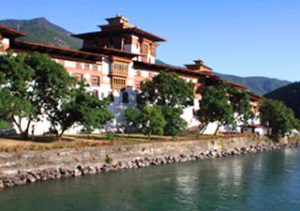 Punakha (alt. 1300m/4265ft) – Punakha served as the capital of Bhutan until and still it is the winter seat of Je Khenpo (the chief abbot). Blessed with temperate climate and owing to its natural drainage from Pho Chhu (male) and Mo Chhu (female) rivers, the Punakha valley produces abundant crops and fruits. There are splendid views of the distant Himalayas at Dochula pas (alt. 3,050m) on Thimphu – Punakha road.
Punakha (alt. 1300m/4265ft) – Punakha served as the capital of Bhutan until and still it is the winter seat of Je Khenpo (the chief abbot). Blessed with temperate climate and owing to its natural drainage from Pho Chhu (male) and Mo Chhu (female) rivers, the Punakha valley produces abundant crops and fruits. There are splendid views of the distant Himalayas at Dochula pas (alt. 3,050m) on Thimphu – Punakha road.
Places of interest in and around Punakha
Punakha Dzong
Built strategically atThimphu town the junction of Pho Chhu and Mo Chhu rivers in 1637, by Shabdrung Ngawang Namgyal to serve as the religious and administrative centre of the region, Punakha Dzong has played an important role in Bhutan’s history. Damaged by four catastrophic fires and an earthquake, the Dzong has been fully restored by the present King. The Dzong is open for visitors during Punakha festival and in summer months when the monk body moves to Thimphu.
Excursions around Punakha
Chimi Lhakhang
The Chimi Lhakhang, situated on a hillock in the centre of the valley, is dedicated to Lama Drukpa Kuenley, who in the late 15th century used humour, songs and outrageous behavior to dramatise his teachings and due to this also known as “Divine Madman”. This temple is also known as the temple of fertility. It is widely believed that couples who do not have children and wanting one, if they pray at this temple, they are usually blessed with a child very soon. It is about 30 minute walk across field from the road to the temple. The trail leads across rice fields to the tiny settlement of Pana, meaning “field”. It then follows a tiny stream downhill to Yoaka and across more fields before making a short climb to Chimi Lhakhang.
Khamsum Yulley Namgyal Chorten A beautiful hike takes one to the regal Khamsum Yuelley Namgel Chorten, which was built to remove negative forces and promote peace, stability and harmony in the changing world. The Chorten dominates the upper Punakha Valley with commanding views across the Mo Chhu and up towards the mountainous peaks of Gasa and beyond.
Sangchhen Dorji Lhuendrup Lhakhang Nunnery
Perched on a ridge amid pine trees and overlooking valleys of Punakha and Wangduephodrang, gleams the magnificent structures of Sangchhen Dorji Lhuendrup Lhakhang(Temple). The temple houses a 14-foot main bronze statue of Avalokiteshvara (Chenrigzig chagtong chentong). Other statues include those of Guru Padmasambawa, Gautama Buddha, Zhabdrung Ngawang Namgyel, Tsela Namsum, the 21 Taras and Tsepamay (Buddha of longevity). The Avalokiteshvara statue, one of the biggest in the country, was the handiwork of entirely local Bhutanese artisans. The temple complex also houses a permanent higher learning and meditation centre for nuns where, apart from religious trainings, it provides life skill training such as tailoring, embroidery, statue making and thangka painting.
Limbukha
Drive towards Punakha Dzong and later walk across the suspension bridge (about 200m long) through absolutely fresh breeze and fascinating view of Dzong. Follow the farm houses gradually climbing towards Dompala hills. The view of Dzong, Pho Chhu, Mo Chhu rivers and surrounding village is superb amidst chirpine forests. The climb is another two and a half hours to Limbukha. Limbukha farmers grow Bhutan’s famous red rice which is supposed to have medicinal values. This particular rice needs clean mountain spring so that the taste is good and nutritional value maintained. Limbukha is also known for its love of peace and tranquility. Legends says that during medieval wars the “limpus” or the people of Limbukha always volunteered as peace negotiators. This is also depicted during yearly festival called ‘Serda’ when the men are found carrying peace flags instead of swords and fireworks.
Talo
The village of Talo (alt. 2,800m) which is scattered along the hill slopes, known for its cleanliness and hygiene among Punakha villages. Talo Sangnacholing is built on a plateau and has majestic view of surrounding villages. The beautiful farm houses of the village have its own flower gardens and on the hill slope corns and sweet peas are grown in abundance. The women of Talo are particular known for their beauty.
Punakha Ritsha Village
Bhutan’s Punakha valley is famous for rice farming where both red and white rice are grown along the river valleys of Pho and Mo Chhu, two of the most prominent rivers in Bhutan. ‘Ritsha’ meaning ‘at the base of a hill’ is a typical village in Punakha. The village houses are made of pounded mud with stone foundations. Each house is only two storey high surrounded with gardens and the rice fields. The gardens also usually have fruit bearing plants like oranges and papaya among the organic vegetables. In the recent years, the farming work is mechanized and power-tillers instead of bullocks are used to plough the fields and villagers have become relatively prosperous. This is a model rice growing village in western Bhutan.
Nalanda Buddhist College
Locals call this place ‘Dalayna’ while the monks refer it as ‘Nalanda Buddhist College’. Drive here in the afternoon and enjoy your evening tea supplemented by the ravishing view in front, along with interaction with local monks.
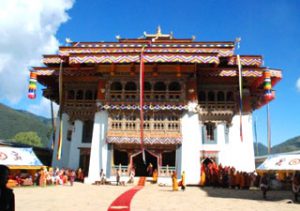 Wangdue Phodrang (alt. 1300m./4265ft) – Wangduephodrang is the last town on the central highway before central Bhutan. The town is not more than an Wangdi Dzong, Bhutanenlarged village with a few well-provided shops. Located in the south of Punakha, the higher reaches of the Wangduephodrang valley provide rich pastureland for cattle. This district is also famous for its fine bamboo products, slate and stone carvings.
Wangdue Phodrang (alt. 1300m./4265ft) – Wangduephodrang is the last town on the central highway before central Bhutan. The town is not more than an Wangdi Dzong, Bhutanenlarged village with a few well-provided shops. Located in the south of Punakha, the higher reaches of the Wangduephodrang valley provide rich pastureland for cattle. This district is also famous for its fine bamboo products, slate and stone carvings.
Places of interest in and around Wangduephodrang
Wangduephodrang Dzong
Sitting on top of the hill at the confluence of Punakha Chhu and Tang Chhu rivers, Wangduephodrang Dzong is town’s most visible features. The Dzong is open for visitors during Wangduephodrang Tsechu celebrated in autumn.
NOTE: Now Wangduephodrang Dzong is no longer available for visit as it is completely gutted down by the devastating fire on 24th June 2012
Gangtey & Phobjikha (alt. 3000m/9845ft)
The valley of Gangtey is one of the most beautiful spots in Bhutan. The surprise of finding such a wide, flat valley without any trees after the hard climb through dense forests is augmented by an impression of vast space, and extremely rare experience in Bhutan where most of the valley’s are tightly enclosed.
A few kilometers beyond the Gangtey Monastery, on the valley floor lies the village of Phobjikha. This place is the winter home of black necked cranes that migrate from the arid plains in the north to pass winter in milder and lower climate. Phobjikha, at an altitude of 2900 m, falls under the district of Wangduephodrang and lies on the periphery of the Black Mountain National Park. The valley boasts two beautiful meandering rivers, Nakay Chhu (Chhu Naap-black water) and Gay Chhu (Chhu Karp-white water).
According to a local legend, the two rivers actually represent a snake and a boar. The two animals once raced each other with an agreement that if the snake (Nakay Chhu) won, Phobjikha valley would be able to grow rice, but if the boar won, then rice could never be cultivated in the area. The snake lost since it had to meander all the way during its journey. Rice cannot be cultivated in the valley even today.
Places of interest in and around Gangtey & Phobjikha Valley
Gangtey Goempa
Perched on a small hill that rises from the valley floor, the Gangtey Monastery is the only Nyingmapa monastery on the western side of the Black Mountain’sGangtey valley, Bhutan and also the biggest Nyingmapa monastery in Bhutan. The Monastery is surrounded by a large village inhabited mainly by the families of the 140 Gomchens who take care of the Monastery.
Gangtey was founded by Pema Trinley, the grand son of Pema Lingpa, the famous Nyingmapa saint of Bhutan. In 1613, Pema Trinley establish the monastery and became the first Gangtey Tulku. The religious traditions of Pema Lingpa still taught there. The second Tulku, Tenzin Legpa Dondrup (1645 to 1726), enhanced the size of Gangtey while keeping up good relations with Drukpas, and rebuilt the monastery in the form of a Dzong.
Black Necked Crane Information Centre
Situated on the edge of the forest and wetland along the main road of Phobjikha valley, the black-necked crane information Centre has an observation room equipped with high power telescope and spotting scopes for catching the best view of the cranes. The centre also offers display information that outline the natural and cultural history of the area. There is a small gift shop, which sells handicrafts produced by the local people.
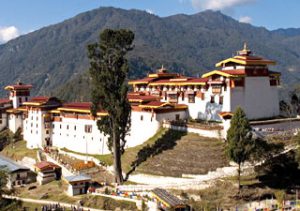 Trongsa (alt. 2300m/7545ft.)
Trongsa (alt. 2300m/7545ft.)
Trongsa forms the central hub of the nation and is Chendbji Chorten Trongsahistorically the place from where attempts at unifying the country were launched. Both His Majesty King Ugyen Wangchuck, the Penlop of Trongsa, who was elected the country’s first hereditary monarch and his successor, King Jigme Wangchuck, ruled the country from Trongsa ancient seat. The Crown Prince of Bhutan normally holds the position of the Trongsa Penlop prior to ascending the throne. including the present King. The entire landscape around Trongsa is spectacular.
Places of interest in and around Trongsa
Chendbji Chorten
Approximate four hours drive from Wangduephodrang is Chendbji Chorten, patterned on Swayambhunath temple in Kathmandu. It was built in 18th century by Lama Shida, from Tibet, to cover the remains of an evil spirit that was subdued at this spot.
Trongsa Dzong
Like almost all towns in the Kingdom, this Dzong architecture dominates the entire Trongsa horizon dwarfing the surrounding buildings. Built in 1648, it was the seat of power over central and eastern Bhutan. Both the first and second King ruled the country from this ancient seat. Protected from invaders by an impenetrable valley, Trongsa Dzong is an impregnable fortress. The Dzong itself is a labyrinth of temples, corridors and offices holding court over the local community. It is built on many levels into the side of the hill and can be seen from every approach to Trongsa heralding its strength as a defensive stronghold.
Ta Dzong
The Ta Dzong, a cylindrical stone structure rising five storeys, was built in 1652 by Chogyal Minjur Tempa, a task entrusted to him by Zhabdrung Ngawang Namgyal. After more than 350 years, it has been resurrected into a classy museum, that represents a tasteful blend of tradition and modernity. There are 224 items on display including a sacred image of Sung Joenma Dorji Chang (self spoken Vajradharna), a bronze statue of Pema Lingpa, made by himself, and a number of centuries-old treasures like dance and ritual costumes and objects, ancient prayer books, paintings and scrolls, and textiles.
The Ta Dzong is a living museum and the main lhakhang in the Utse is dedicated to the Maitreya Buddha (Gyaltsab Jampa), also known as the Future Buddha). A Khesar Lhakhang is dedicated to Khesar of Ling. The tower has always been a place of retreat and there are hermits in practice, including two yogis, who are in life long meditation. The Ta Dzong is the only structure that has been restored specifically to tribute the Wangchuck dynasty as Bhutan celebrates the centenary of the Monarchy. Excursion around Trongsa
Kuenga Rabten
The 23 km drive from Trongsa to Kuenga Rabten takes about an hour and passes through open countryside, high above a river gorge. The land slopes quite gently in this region, and farming is well developed, so there is much of interest to observe in the field and in the villages as one speeds along. Kuenga Rabten was the winter palace of the second King and is now looked after by the National Commission for Cultural Affairs. The building has a superb wood work and decorations. At present part of the palace is used as library. The top floor has an alter room with statues of Shakyamuni, Shabdrung and Guru Rimpoche. From the palace, one can take a hike up to the road and further along the village to a nunnery. The duration of the hike is about 25 minutes, with gradual ascent. There are about 80 nuns residing at the nunnery and one can visit their hostel, the main shrine and their dinning hall. This pleasant excursion from Trongsa offers further insights into the early days of Bhutan’s monarch.
Semji Village – Trongsa
This ancient village is approx. 7km from Trongsa and ideal for bird watching. Weather permitting, hiking through the dense forest provide ample opportunity to see various species of birds. At Semji, one can visit the village and subsequently continue hiking downhill till the high way, where your transportation can shuttle you back to Trongsa town. The whole hiking trip takes approximately 4-5 hours.
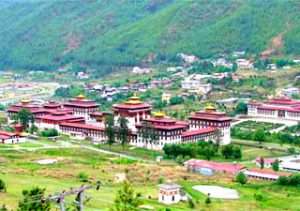 Bumthang or Jakar valley (alt. 2600m-4500m / 8530ft-14765ft)
Bumthang or Jakar valley (alt. 2600m-4500m / 8530ft-14765ft)
Bumthang has an individuality that charms its visitors and separates it from other regions. Comprising of four smaller valleys namely Tang, Ura, Choekhor and Chumey, the deeply spiritual region of Bumthang is shrouded in religious legend. Bumthang is also the traditional home to the great Buddhist teacher Pema Linga to whose descendants the present dynasty traces its origin.
Places of interest in and around Bumthang or Jakar
Jambay Lhakhang : This monastery was built in the 7th century by Tibetan King, Songtsen Gampo. It is one of the 108 monasteries built by him to subdue evil spirits n the Himalayan region. Its present architectural appearance dates from the early 20th century.
Kurje Lhakhang : Kurje Lakhang Bumthang BhutanSituated before Jambay Lhakhang, Kurje Lhakhang consists of three temples. The one on the right was built in 1652 on the rack face where Guru meditated in the 8th century. Second temple is built on the site of a cave containing a rock with the imprint of Guru’s body and is therefore considered the most holy. The third temple was built in 1990s by Ashi Kesang, the Queen Mother. These three temples are surrounded by a 108 chorten wall.
Tamshing Lhakhang: Located across the river from Kurje Lhakhang, this temple was founded in 1501 by Terton Pema Lingpa, the re-incarnation of Guru Padsambhava. The monastery has very ancient religious paintings like 1,000 Buddhas and 21 Taras (female form of Buddhistava). The temple was restored at the end of the 19th century.
Jakar Dzong : Founded by great grand-father of the first Shabdrung, the Dzong was initially built as a monastery in 1549. It was upgraded after the Shabdrung had firmly established his power in 1646. The Dzong is now used as administrative centre for Bumthang valley, and houses the regional monk body.
Konchogsum Lhakhang: It was built in the 6th century but was renovated in 1995, which accounts for its fresh look. It contained a large bell and it is said that when this bell was rung it could be heard all the way in Lhasa in Tibet. During the 17th century a Tibetan Army tried to steal this bell but was too heavy and they dropped it and cracked it. It is now displayed at the National Museum in Paro.
Chankhar Lhakhang : Beyond Jambay Lhakhang is Changkhar Lhakhang, the site of the palace of the Indian King Sindhu Raja. Because of its simplicity it looks like an ordinary village house. The original palace was built of iron and this is why it was named Chankhar, meaning iron castle. It was rebuilt in the 14th century by a Saint called- Dorji Lingpa.
Lhodrak Kharchhu Monastery:
Located above the main town, about 3 km from Chamkhar town, the monastery was founded by Namkhai Nyingpo Rinpoche in 1984 who was recognized at a very young age by H.H. the 14th Dalai Lama and H.H. 16th Karmapa as the reincarnation of a Tibetan lama whose spiritual lineage dates back to the nearest disciples of the great 9th century master. Since then the monastery has developed considerably with increase in number of monks to almost four hundred. The monastey has become part of an extensive effort to preserve and revitalize Tibetan culture. The monks regular curriculum include reading, memorizing the daily prayers, learning dharma dances, drawing mandalas, learning the melodies of sacred rituals, learning the use of ceremonial instruments and the art of making sacrificial objects, grammer, poerty, karika along with the basics of contemplation and instruction on the different stages of tantra.
Excursions around Bumthang or Jakar valley
Tangbi Goemba: A walk of half an hour north of Kurje Lhahang leads to this monastery, founded in 1470 by Shamar Rinpoche of the Kagyupa religious school. The temple has two sanctuaries and a temple of terrifying deities. The sanctuary on the ground floor contains statues of past, present and future Buddha and three clay statues probably dating end of the 15th century. On the upper floor, the vestibule contains two remarkable paintings of Guru Rinpoche’s heaven and the Buddha Amitabh’s heaven.
Ngang Lhakhang: A few hours walk from the Tangbi Goemba is the small region of Ngang Yul (Swan Land) and this temple here is 100 m above the valley floor. The site was visited by Guru Rinpoche and present temple was built in the 15th century by Lama Namkha Samdup, a contemporary of Pema Lingpa. A three days festival is held here each winter with masked dances in honor of the founder of the temple.
Ura Valley: Jakar to Ura is 48 km, about one and a half hour drive. To reach here, the road climbs toJakar valley Bhutan amazingly open countryside, only occasionally running into forest. Large sheep pastures line the road up to 20 km behind the southern tip of the Tang valley. The route crosses Ura la pass (3,600m) with a magnificent view of Mount. Gangkhar Puensum. Villages in Ura have clustered houses, which is quite unusual in Bhutan. Above Ura village (3,100m) is a new temple dedicated to Guru Rinpoche. Inaugurated in 1986, it contains a huge statue of the master and remarkable paintings of the cycle of his teachings. Since last 25 years Ura has been transformed from a marginal community to prosperous valley.
Tang Valley: Terton (treasure discoverer) Pema Lingpa, the famous saint, was born in the Tang valley of Bumthang. The people of this valley raise sheep and at higher elevation, yaks as the soil in this region is not so rich for agricultural activities. From Bumthang central, it is a short drive past the Dechenpelrithang sheep farm to an unpaved road that leads to the north. Just under a kilometer ahead, there is a rough track on the left and another kilometer ahead, there is junction where vehicle can be parked. From parking, it is a short walk down to the river. The path is lined with prayer flags and ends up above a gorge where the river forms a pool before it rushes on. Images of Pema Lingpa and his two sons are carved on a rock here.
Membartsho (The Burning Lake) in Tang valley is a wide spot on the Tang Chhu (chhu – water / river) and is considered to be one of the greatest pilgrimage sites of Bhutan. Pema Linga found several of Guru Rinpoche’s hidden treasures here. The importance of this site is indicated by the extensive array of prayer flags and the small clay offerings called ‘Tse Tsa’ in rock niches.
Ugyenchholing Palace in Tang valley is another attraction. Restored in 19th century, it is now housing the Family Museum, a place that will transport visitors to another world and time. The visitors will view permanent exhibits recreated to capture the ambience of the lifestyle of the Trongsa Penelop (Governor) Tshokey Dorji and his household. It also serves as retreat for those engaged in religious history. Bhutan’s history truly unfolds here.
Tang Rimochen Lhakhang in the valley is a sacred place of Guru Rimpoche. A rock in front of temple bears a body print of the Guru and two khandroms (female celestial being). The site is named after the tiger stripe markings on the cliff. Footprints of the Guru and his consorts Mandarava and Yeshe Chhogyal are found below the lhakhang. Two large boulders nearby are said to be male and female jachungs (garudas).
Kunzangdrak Goemba is two hours walk above Chel Tang Valley. It is one of the most important sites related to Pemalingpa the great treasure discoverer in Bhutan, who also constructed the Goemba in 1488. Most of his sacred relics are kept here including the gilded stone bearing his footprint.
Pelseling Goempa Pelseling Goempa is a sacred monastery with rich historic values. Situated on a steep mountain, it is a half day trek (3-4 hours) from the area of Jakar. The trek starts off at a mild pace but later gains momentum. Along the trek route, travelers are gifted with breathtaking views of the valley and large species of flora and fauna. About two thirds of the way, there is a beautiful meadow which is the perfect picnic spot. The last part of the hike requires more uphill trek until eventually the destination is on sight.
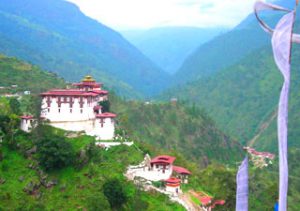 Mongar (alt. 1600m/5250ft) & Lhuntse(alt. 2323m/7621ft)
Mongar (alt. 1600m/5250ft) & Lhuntse(alt. 2323m/7621ft)
The journey from Bumthang to Mongar is en route to mongar Bhutanone of the most beautiful in the Himalayas crossing 4,000m high Thrumshing la (pass). Gushing waterfalls, steep cliffs with even steeper drops, blazing flowers and constantly changing vegetation combine to make this journey as varied as it is beautiful. Mongar marks the beginning of Eastern Bhutan. The second largest town in the sub-tropical east, Mongar like Trashigang further east, is situated on the side of a hill in the contrasts to other towns of Western Bhutan which was built on the valley floor.
Places of interest in and around Mongar
Mongar Dzong
It is site of one of Bhutan’s newest Dzong built in 1930s. Yet the Dzong is built in the same method and traditions of all the other Dzongs; no drawings and nails have been used. A visit gives visitors an impression of how traditional Bhutanese architecture has continued to thrive through the centuries.
Yakang Lhakhang
Located at about 20 minutes walk from Mongar town, this privately owned monastery was founded by Lama Sangdag, the sixth son of Terton Pema Lingpa. It is of great cultural significance and a repository of a wide range of spiritual treasures and other sacred objects known to have been revealed by Terton Pema Lingpa.
Drametse Lhakhang
Dramtse Lhakhang means, ‘the peak without enemy’, is one of the largest and most important monastery in eastern Bhutan, situated about 18 km away from Trashigang to Monger highway. The lhakhang was founded by a highly accomplished Ani (nun) named Choten Zangmo in the 16th century, the granddaughter of the famous religious master Terton Pema Lingpa (the Treasure Discoverer). The lhakhang is deeply associated with Terton Pema Lingpa and the Peling tradition of Buddhism. It houses a full range of spiritual treasures and other sacred objects and is the source of spiritual inspiration to the people of Drametse and neighbouring communities.
The local people from Mongar and Trashigang gather at Drametse Lhakhang to witness the annual religious festival, celebrated every year on the 10th day of Bhutanese calendar and locally known as Kaggsol Chenmo, Trel Da Tshechu and Daw Drugpai Choep. The Drametse Ngacham (Dance of the drums of Drametse) was established by Lam Kuenga Gyeltshen, Ani Chhoeten Zangmo’s brother and
Excursion around Mongar
Lhuntse
Lhuntse is 77 km from Mongar (3 hours drive) and is one of the most isolated districts in the country. The landscape here is spectacular with stark cliffs and gorges and dense coniferous forests. The region is notably famed for its weavers and their special textiles generally considered to be the best in the country. The Kurtoe region of Lhuntse is also the ancestral home of royal dynasty.
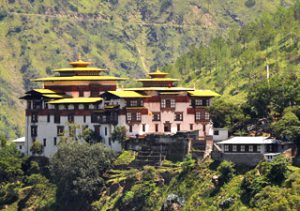 Trashigang (alt. 1100m/3610ft) – In the farRanjung monastery Trashigang Bhutan east of Bhutan, on the bank of Gamri Chhu river lies Trashigang, the country’s largest district. Trashigang, once the centre of a busy trade route with Tibet, is today the junction of east-west highway with road connecting to Samdrup Jongkhar and then to the Indian States of Assam. This town is also used as the market place for the semi nomadic people from Merak and Sakteng whose costumes are unique in Bhutan.
Trashigang (alt. 1100m/3610ft) – In the farRanjung monastery Trashigang Bhutan east of Bhutan, on the bank of Gamri Chhu river lies Trashigang, the country’s largest district. Trashigang, once the centre of a busy trade route with Tibet, is today the junction of east-west highway with road connecting to Samdrup Jongkhar and then to the Indian States of Assam. This town is also used as the market place for the semi nomadic people from Merak and Sakteng whose costumes are unique in Bhutan.
Places of interest in and around Trashigang
Trashigang Dzong
Built in 1659, the Dzong serves as the administrative seat for the district as well as the home of the monk body. The Dzong commands a remarkable view over the surrounding countryside.
Gom Kora – 24 km from Trashigang, the temple of Gom Kora is set on a small alluvial plateau overlooking the river. Surrounded by rice fields and clumps of banana tress, it looks like an oasis in an arid landscape. It is one of the famous places where Guru Rinpoche meditated in order to subdue a demon who dwelt in a huge black rock.
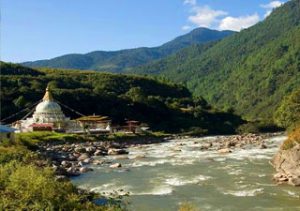 Trashiyangtse (alt. 1700m/5580ft)
Trashiyangtse (alt. 1700m/5580ft)
Trashiyangtse is a rapidly gom Kora templegrowing town and administrative center of the district. Situated in a small river valley, it is a lovely spot from which to take walks in the surrounding countryside. The dzong overlooking the town was built in the late 1990s when the new district was created. Trashiyangtse is famous for its wooden containers and bowls, which make inexpensive, attractive and useful mementos of a visit to this remote region.
Places of interest in and around Trashiyangtse
Chorten Kora
This dazzling white stupa is situated on the riverbank below the town. Constructed in 1740 by Lama Ngawang Loday, it is built in the same style as Bodhnath stupa in Nepal, with eyes painted at the four cardinal points. During the second month of the lunar calendar there is an interesting celebration here, known as ‘Kora’. Bomdeling A pleasant walk of about three hours from Chorten Kora, Bomdeling is an annual migration place for black-necked cranes, which fly over from nearby Tibet to pass the winter months in a warmer climate.
Trashiyangtse Dzong
Trashiyangtse Dzong meaning ‘Fortress of Auspicious Fortune’, was re-built in 1656 by Terton Pema Lingpa from the ruins of Dongdi Dzong of 9th century. It was further renovated and sanctified by a sacred consecration ceremony in 2005.
Excursion around Trashiyangtse
Bomdelling
A pleasant walk of about three hours from Chorten Kora, Bomdeling is an annual migration place for black-necked craens, which fly over from nearby Tibet to pass the winter months in a warmer climate.
Ranjung Woesel Chholing
This monastery is more than half an hour drive from Trashigang town. It is a Nyingmapa monastery founded by Garab Rinpoche in 1990. One can get a good view of the valley from the monastery.
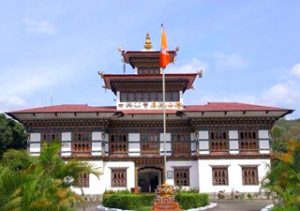 Samdrup Jongkhar (alt. 280m / 920ft) – The road from Trashigang to Samdrup Jongkhar,en route Samdrup Jongkhar completed in 1960s, enables the eastern half of the country to access and benefit from trade with the south as well as across the Indian border. There is little to see in this area, other than the busy market which straddles the border.
Samdrup Jongkhar (alt. 280m / 920ft) – The road from Trashigang to Samdrup Jongkhar,en route Samdrup Jongkhar completed in 1960s, enables the eastern half of the country to access and benefit from trade with the south as well as across the Indian border. There is little to see in this area, other than the busy market which straddles the border.
Samdrup Jongkhar is a convenient exit town for tourists who have arranged to visit the neighboring Indian state of Assam.
